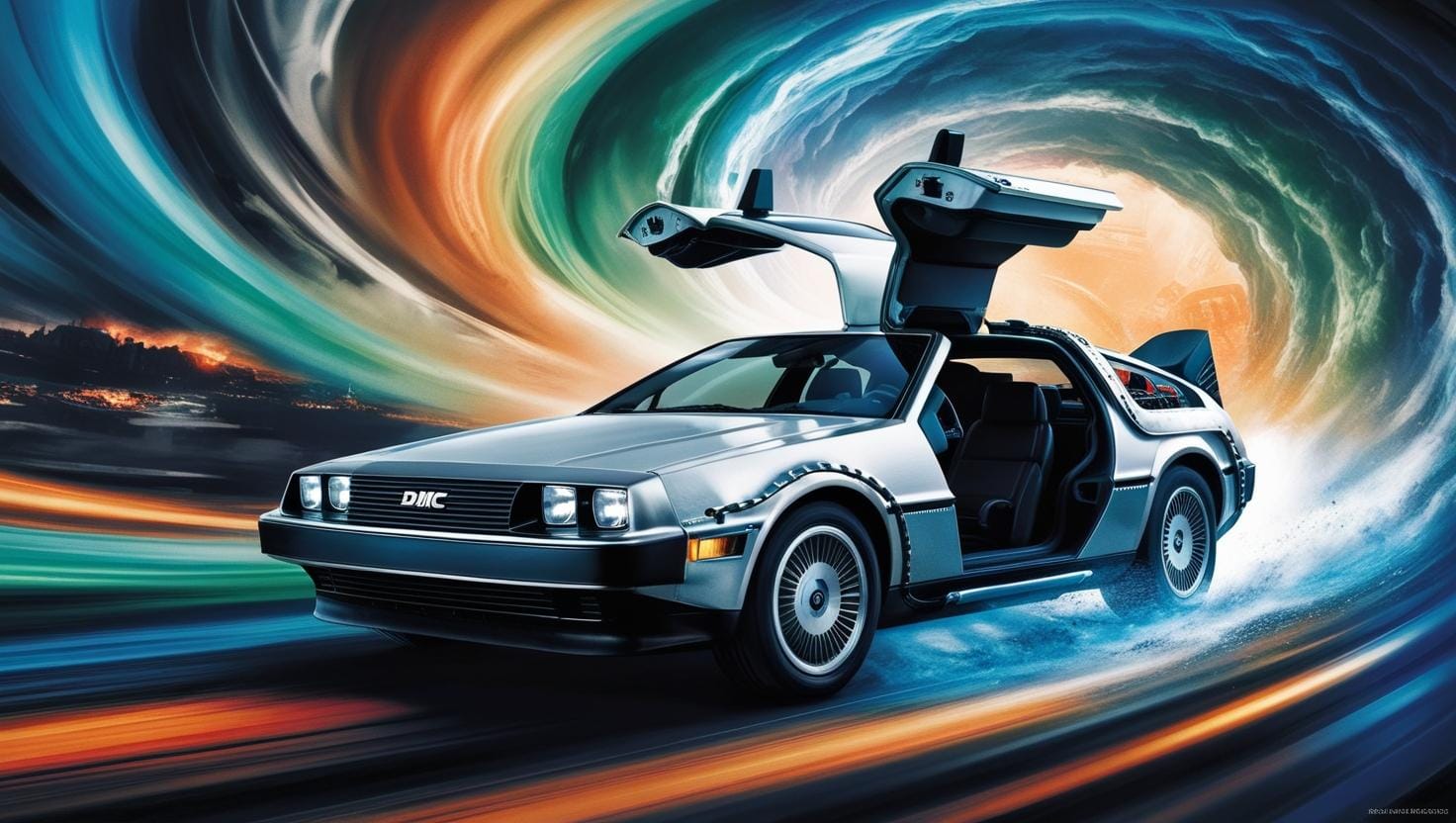Nuclear Energy

In my last article I wrote about time travel. One method used for time travel in fiction was the popular DMC DeLorean Time Machine from the back to the future series. Fittingly it is powered by radioactive Plutonium and needs a power input of 1.21 Gigawatt to work. So naturally I asked myself the question how much Plutonium is needed to power it? And if the flux capacitor is powered by nuclear energy, why is the vehicle itself running on gas?
Lets just determine what we understand as 'nuclear energy'. Nuclear generally refers to energy produced by nuclear fission or nuclear fusion. Since fusion is not yet a technique used by men, we usually refer to nuclear fission. A heavy element gets excited by means of neutron bombardment until its nuclear core splits into two more stable and lighter cores thus creating two other elements. In this process a lot of energy is produced. Common nuclear fissionable elements are Uranium and the Plutonium used in Back to the Future.
First of all Plutonium comes in more than one form. As any element in the periodic table it is defined by the number of protons in its core. These are 94 protons for Plutonium, but it has various isotopes with different number of neutrons. In chemistry an element is written like ⁴He, where 'He' is the element symbol (in this case it's Helium) and 2 determines the number of nucleons e. g. the sum of neutrons and protons. Since the element symbol also determines the number of protons, the number of nucleons directly determines the number of neutron. Since Helium has two protons, ⁴He consists of two neutrons and two protons. ²⁴⁰Pu is a common and relative stable isotope of Plutonium consisting of 94 Protons and 146 neutrons, but it is not fissionable. For energy generation by nuclear fission, we normally need an odd number of neutrons. Commonly used in reactors are ²³⁵U or ²³⁹Pu. Since pure ²³⁹Pu is not possible to make, generally ²⁴⁰Pu is enriched to make it reactor grade or weapons grade. This naming refers to the purity and is defined by the percentage of ²⁴⁰Pu still left. Reactor grad contains about 18% ²⁴⁰Pu and Weapons Grade only contains about 3 to 7 percent of ²⁴⁰Pu.
Well lets assume Doc Brown got his hands on weapons grade plutonium, because he originally was meant to build a bomb with it...
First we need to think about how long do we need an energy of 1.21 Gigawatt - lets assume a jump through time only needs energy for about ten seconds - this makes calculations easier. So we need an energy of 12.1 Gigajoule.
So we need a lot of Joule for this adventure. Lets look at what one atom of ²³⁹Pu creates 207.1 MeV in energy when it fissions, which is a lot in terms of energy.
1 eV equals roughly 1.602 × 10⁻¹⁹ J. So one fission of ²³⁹Pu creates about 3.316 × 10⁻¹¹J, still a really tiny amount on our overall scale. If we divide out 12.1 Gigajoule by it, we see, that we need about 3.65 × 10²⁰ fissions for this energy.
Now we can approximate, that one gram of Plutonium contains about 2.52 x 10²¹ atoms, so we can calculate, that we need about 0.145 g of ²³⁹Pu to release an Energy of 1.21 Gigawatt for ten seconds. This is the answer physics gives us, but in a real reactor the usable energy of ²³⁹Pu is estimated at 80.8 MJ per gram. So lets revisit our calculation.
We only have about 93% of ²³⁹Pu so we calculate with a power of 75.15 MJ per gram. If we divide our 12.1 Gigajoule by this, we get a number of 161 gram for our flux capacitor. Which is far more, than physics would lead us to believe. Only downside is that ²³⁹Pu only gets critical at 11 kilogramm in a sphere. So the reactor in our DeLorean doesn't run continous and only allows for one small burst of energy. This is why Doc needs to change the Plutonium after every use. And 161 gram is a reasonable amount for every day use. This would have cost about half a million dollars back in 1985. So in conclusion the nuclear reactor in the DeLorean is a costly firework, since it is not a real reactor rather than an engine starter.
Now lets dive into our second question. Why don't we see nuclear powered vehicles today? Well first of all, there were nuclear ships back in the 1950s like the USS Nautilus, which was a nuclear powered submarine deployed by the US in 1955. After that there ships like the icebreaker Lenin build by the soviet union, and the Otto Hahn from Germany.
The nuclear hype in the 1950s & 1960s led to experimenting with different types of ships powered by nuclear energy. But they weren't that popular. For example the german transport ship Otto Hahn did cruise the sea a bit, but were not allowed to lay a shore in many cities due to the risks it possessed. Also there is always the problem of waste disposal. Used up fuel rods must be taken out of the reactor, but there was literally no place on ship to store them over a long period.
Nuclear powered planes where also considered for a while, but none ever left the surface when only powered by nuclear energy. At the height of 1950s automobile hype there where also different types of nuclear powered cars - most notably the FORD NUCLEON. But it was calculated that a 1 400 kg car would need a reactor almost weighing 36 000 kg. All ideas where abandoned for these cars and planes.
Today only a handful of nuclear powered vehicles remain. Most notably are the aircraft carrier of the Gerald-R.-Ford-Class used by the US-Military which ware wholly powered by the A1B-Reactors which use weapons grade Uranium. It was highly controversial why the USA would use weapons grade Uranium for a reactor, but they still do for a higher life span of the reactor on board.
Lastly I want to mention the Mars Rover Curiosity which is powered by a radioisotope thermoelectric generator. This does not use nuclear fission of elements to move forward but rather the energy set free by the natural decay of radioactive decay. In this battery the mars rover uses ²³⁸Pu which has a half life of 87.7 years and emits alpha particles.
In conclusion nuclear energy remains an interesting concept for different usages. It opposes many dangers for its users, that is why we see it so sparely in everyday life.
I hope you liked this article; if so let me know in the comments below. Sign up to stay up to date and don't miss out on future articles. The next one will be far less physics ;)

